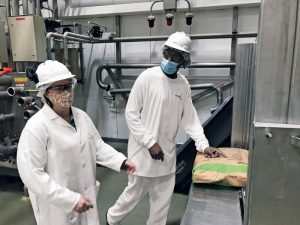
Recruiting is a Game of Inches: Why the Candidate Experience Matters More Than Ever
Workforce Genetics is the executive and scientific search division sister to BioBuzz Media that provides unparalleled recruiting services to venture-backed and growth stage biotechnology companies.
It’s no secret that we are in the most competitive talent market that most of us have ever seen.
Candidates are in the driver seat. There is intense inflationary pressure on compensation. Skills gaps, scarcity of available talent and a new and long overdue push for diversity, equity and inclusion programs have forced many employers to rethink their hiring and training models.
So, what is your company doing to win the recruiting game?
One of my Dad’s favorite movies is “Any Given Sunday” where Al Paccino gives an inspirational speech to his team instilling in them that “Football is a game of inches” and every inch of effort can make the difference between winning or losing. The same is true for recruiting and the best talent acquisition teams understand that.
What you do as a company and the strategies you choose determine your success. And everything matters because recruiting, like football, is a game of inches.
There are so many touchpoints and engagements within the recruitment life cycle, and each one can make a difference. Each engagement with your brand is critical; starting with the first time they learn about you, to a candidate’s decision to apply, to accepting an interview opportunity, and ultimately to accepting an employment offer. Each stage is an opportunity to win a candidate’s continued interest or to lose it and have them drop out of the process.
The candidate experience has always had an influence on their ultimate decision, but today it’s happening in a pressure cooker where demand is at an all time high, so candidates have more options than in the past. Today’s candidates are also more educated, with more ways to evaluate an employer and ultimately more aware of their experience in the job process.
While many larger companies have invested time and attention into employer branding and promoting their Employee Value Proposition (EVP), many companies and leadership teams still don’t fully grasp the importance of strong Employer Branding when it comes to candidate experience and talent acquisition.
When I say Employer Branding I’m not talking about social media posts from your company or team building outings, though this does have value within a larger branding strategy. Rather, I’m talking about the actual building, executing and sustaining of an intentional Employer Branding strategy that is adopted from top down within the organization.
How a candidate experiences your Employer Brand during their candidate journey is something that you and your leadership can control. The very best employers are clear on their brand and very intentional about creating a positive employer brand experience during the entire hiring process.
I promise you that embracing Employer Branding and integrating your brand into the candidate experience will make an enormous difference in the recruiting game.
Candidates are unpredictable because, well, they’re people and people are complex. Therefore, controlling what you can control in the talent game goes a long way to increasing your chances of hiring the talent you need and beating your competition to the punch. How your company’s EVP, culture, mission and professional development platform are delivered to your job seeker audience can mean everything in a fiercely competitive job market.
So yes, Employer Branding can make a big difference in winning the talent wars.
I can’t stress this enough because I have seen too many great candidates fall out of the pipeline because of a disjointed and poor candidate experience.
To avoid this, let’s take a look at some important elements that can make a big difference in the recruiting game of inches.
Don’t Overlook Your Job Descriptions
Job descriptions are often the first touch point for a candidate and their first experience of your brand. The growth of programmatic job advertising has really helped employers to improve response rates on jobs by ensuring that job ads are in front of the right people, at the right time, at the best possible price. Therefore, the quality of your job description could play a deciding factor by attracting the right candidate and getting them to apply.
How you write your job descriptions matters. Gone are the days where a job description can be just a grocery list of skills and responsibilities that you’re seeking. Here are some tips:
- Grab their attention from the start with a compelling, on-brand opening statement
- Write in the second person voice (using the pronoun ‘you) to address the job seeker directly
- Focus responsibilities on growth and development.
- Keep it short – because long job descriptions will lose the core essence of what you are hiring for.
- Keep it inclusive and avoid gender-coded words or too much corporate jargon
- Be transparent – include pay and benefits information… and don’t forget to plug your culture.
Since there are more ways than ever before for a candidate to find your job ad—social media, your website, job boards, media placements, referrals, etc – to name just a few possibilities, it’s critically important that your job description reflects your company well, is tailored to your target audience and is written from a candidate’s perspective.
Responsiveness Matters
Meaningful communication and appropriate responses to a candidate’s first contact with your company is critical for their experience. This can be an automated response to a job application submission or a personalized response after a candidate reaches out via LinkedIn, for example. This responsiveness, and particularly any kind of personalized communication with a candidate, indicates right away that your company is organized, values their interest and is serious about hiring.
Since not getting feedback on an application is one of the things job seekers get frustrated with the most, this is an opportunity for your company to shine. In most cases, it’s really that simple to get off to a great start with a candidate and smooth the way for them to move through your recruiting process. Almost all ATSs and many job boards now offer some form of automated response mechanism that you can set up.
Here are some tips for your automated responses:
- Thank them and be personable, avoiding corporate jargon
- Manage expectations – i.e. let them know how long it typically takes to get a response
- Give them additional information to review – like a blog or stories of other employees
- Provide them additional ways to stay connected – i.e. your talent community, social media, a newsletter, etc.
There are many more complex and deeper strategies for nurturing candidates, but this first act of responsiveness and engagement builds that initial relationship and gets the process off on the proverbial right foot.
Executive Buy-in & Training is Essential
Your Executive and HR leaders need to buy-in to the importance of the company’s employer brand and understand how it is projected through the job candidate experience. If this is driven from the top down in your organization then a consistent message and experience can be created. Talent leadership then needs to train and drive buy-in from the hiring teams on “why” and how to deliver a great candidate experience.
Feedback that we often get from candidates after they interview is that they heard a different message from various people that they spoke with during the interview process. This may be the hiring manager telling a different story than the initial recruiter, or several members of the hiring team having a different understanding of the job, or worse yet, different feedback on the working for the company and its culture. This can cause confusion, doubt and ultimately may lose you a good candidate.
As an executive or HR leader, it’s your job to ensure hiring managers and your entire talent team are all trained on good interview practices and effective candidate communication, and are able to succinctly communicate the Employer Brand pillars and your EVP through the lens of their department. You don’t want your entire company to sound robotic when talking about the company, but each member of the hiring team should be trained on how to communicate the EVP and how to talk about the jobs that they are hiring for.
The Interview Stage Needs to be Meticulously Organized and Purposeful
Employers spend an incredible amount of time, energy and money to get candidates into the interview process, but then the thing that I see most often is that they mess up and lose great candidates because they’re disorganized, ill prepared or lack an interview strategy. The interview process from the first screening interview through to the final interview should be planned and purposeful.
Your interview time with a candidate is the most meaningful and engaging moment you have with them. If it feels disjointed and chaotic or your simply don’t communicate expectations or take too long, it reflects terribly on your Employer Brand and will make a candidate question whether this disorganized process is emblematic of how your company operates overall. Lack of planning will also lead to an unnecessarily long interview process, during which another competitor can swoop in and scoop up the talent you’ve been working so hard to hire.
In today’s market, you cannot sleep on good talent. If a candidate has to wait too long for interview feedback and to schedule their next interview, or there are too many steps in between, this will create a bad candidate experience and you will invariably lose this talent to another company that has a tight, well-crafted interview process.
We see this mistake all the time. Nothing is more frustrating as a Search Firm than when we have really good candidates start the process totally psyched about the company and bought in only to lose them because the interview process took three or four weeks to finalize an interview meeting.
If you take nothing else from this article, take this point to heart and do the work to get it right.
There are several other elements that can shape the candidate experience, but for now I want to make sure I drive home this important message: recruiting is a game of inches! If you want to recruit and retain the best talent then you must put in the work, especially at the most critical junctures in the candidate journey that have the greatest impact.
- About the Author
- Latest Posts
Over the past 11 years, Chris has grown BioBuzz into a respected brand that is recognized for its community building, networking events and news stories about the local biotech industry. In addition, he runs a Recruiting and Marketing Agency that helps companies attract top talent through a blended model that combines employer branding and marketing services together with a high powered recruiting solution.








